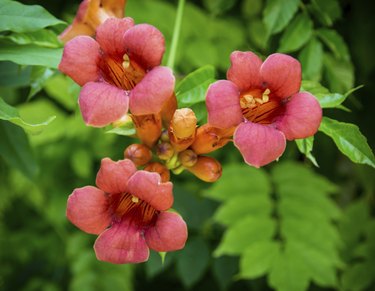The trumpet vine (Campsis radicans) typically begins to bloom in mid-summer and continues until early autumn. A vigorous climber, it can clamber 40 feet or more up a post or tree in U.S. Department of Agriculture plant hardiness zones 4 through 9. Once established, it brandishes feathery fronds up to 15 inches long and red or orange trumpet-shaped flowers 3 inches long and 2 inches across. Wildly attractive to hummingbirds, the plant also is wildly invasive. According to gardening author and columnist Melinda Myers, a trumpet vine that refuses to flower may be too young, too shaded or too pampered.

Video of the Day
Too Young
B. Rosie Warner of Purdue Extension warns that a trumpet vine started from seed can take as long as 10 years to bloom. Even one propagated by other means may take a few years to establish itself before it gets around to making flowers.
Video of the Day
If the vine is growing against a broad-enough support, PennLive's George Weigel suggests gardeners try training its main branches into a horizontal rather than vertical growth pattern as horizontal branches are more likely to bloom. Warner advises gardeners only prune the plant in late winter or early spring before it begins to leaf out. Gardeners who wait until late spring to tackle this task may cut off buds.
Warning
Always wear gloves while handling the plant, as it may raise a rash on sensitive skin.
Too Shaded
A trumpet vine growing in the sultry South can thrive in partial shade, but Alan Charest of the National Gardening Association emphasizes that one in a northern climate needs as much sunlight as possible -- to provide the warmth that spurs it into bloom. If you position yours on a support in the center of a sunny lawn, you also can easily mow off its suckers and seedlings, thus preventing the plant from becoming invasive.
Too Pampered
Although it doesn't seem fair, a neglected trumpet vine often will bloom better than a coddled one. As Mr. Smarty-Plants of the Ladybird Johnson Wildflower Center points out, a plant that has been pampered with lots of water and high-nitrogen fertilizers is likely to put out rampant new foliage rather than flowers. To prevent this, don't feed a trumpet vine unless you use a low-nitrogen fertilizer. Decreasing the amount of water you give it could also help switch it from leaf production to flower production mode.
Desperate Measures
Mr. Smarty-Plants suggests that a desperate gardener with a clearly mature vine that still doesn't bloom might want to try shovel-pruning it. This involves drawing a dotted circle around the plant with a sharp spade, about 2 feet back from the trunk, by thrusting that spade into the ground at intervals. Leaving spaces between those thrusts will sever only part of the vine's roots while leaving the others intact and may "shock" that vine into blooming.
- Missouri Botanical Garden: Campsis Radicans
- Melinda Myers: Increase Bloom on Trumpet Vines
- Ladybird Johnson Wildflower Center: Ask Mr. Smarty-Plants
- Chicago Tribune: Why Is My Trumpet Vine Not Flowering?
- The National Gardening Association: Trumpet Vine
- University of Illinois Extension: Vines: Climbers & Twiners
- Pennlive: When Is My Trumpet Vine Gong to Bloom?
- Purdue Extension: Question and Answer